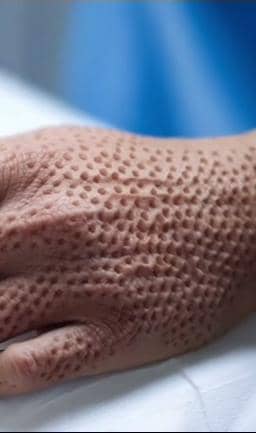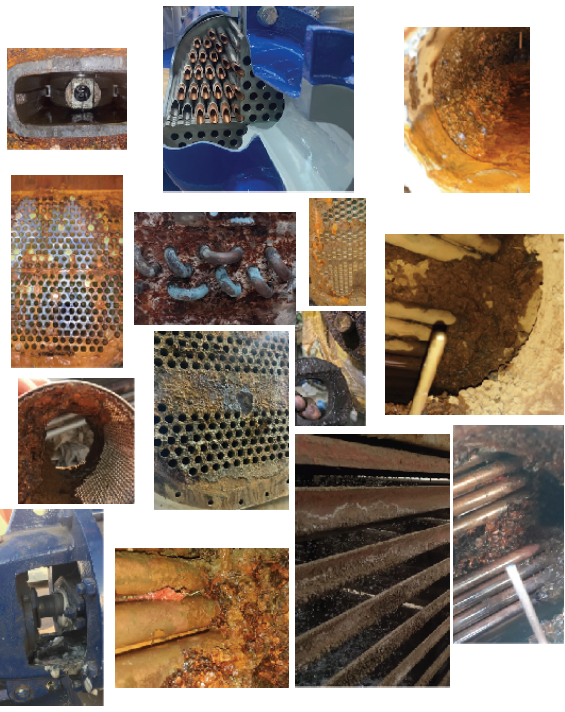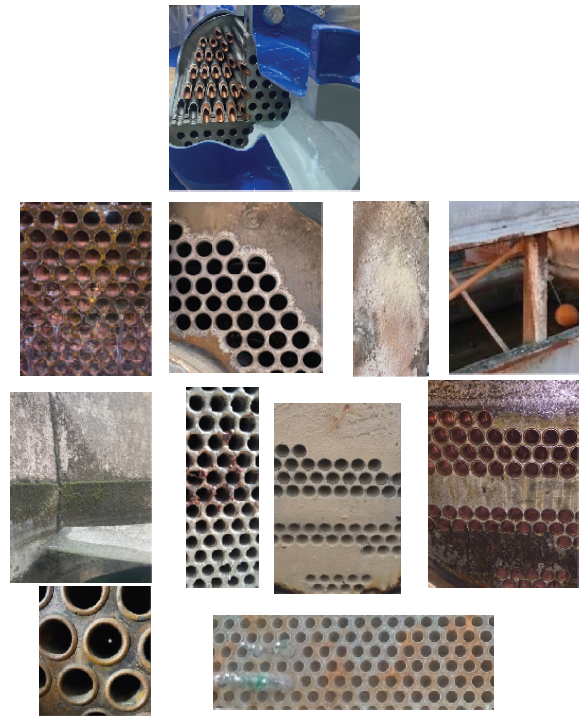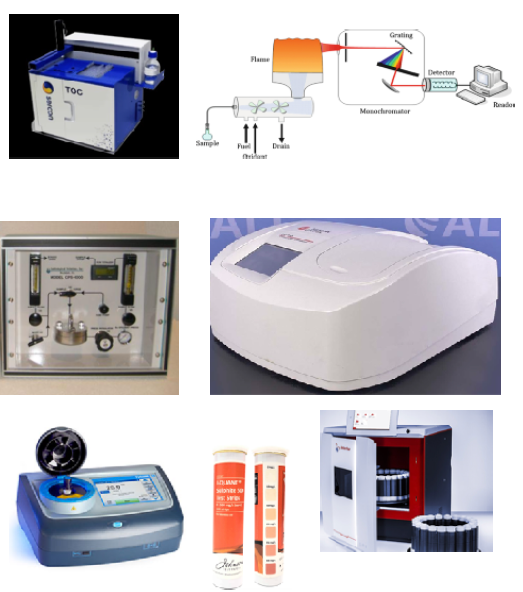معالجة مياه التبريد وتحليلها

Background
Correct cooling water treatment and follow-up of the cooling water condition are of utmost importance for keeping the cooling water systems of the engines in good condition. The corrosion processes that could occur due to a bad cooling water quality may under certain circumstances be local and by their nature proceed very rapidly. This may cause unexpected operating problems or engine failures even within relatively short periods of time, for example in the cylinder head exhaust valve seat pockets and other areas prone to corrosion (see further comments in the “Worth noticing” chapter below) in the cooling water systems of the engines.Most of the cooling water additives which are approved by Wärtsilä are nitrite (typically NaNO2) based and today the majority of the installations in operation are also using nitrite based additives. There is a slow trend towards more environmentally friendly alternatives. These operating instructions and recommendations are mainly intended for installations using nitrite based additives but certainly contain useful information for users of other types of additives.
Purpose
To avoid unnecessary corrosion damages and operating problems in the cooling water systems of the engines.
Instructions & Recommendations
Raw water qualityThe raw water quality for the cooling water circuits of an engine must meet the following specification:*) A total hardness of 10 °dH (German degrees) ↔178 mg/l (as CaCO3).Soft waters (like distilled, ion exchanged, reverse osmosis and rain water) with a total hardness close to 0 °dH have the ability to dissolve oxygen and carbon dioxide from the air, which quite rapidly lowers the pH levels and increases the corrosive effect of these waters. Suitable amounts of calcium and magnesium compounds (= total hardness) participates in forming a thin,corrosion protective layer on the heat exchanging surfaces of the cooling water system. Correct additive dosage and careful follow up of the dosing levels are thus even more important with a very soft water compared to anormal quality tap/drinking water with a total hardness of 2 – 10 ° dH. The use of raw water qualities with a too high total hardness may on the other hand result in excessive deposit formations and reduced heat transfer properties. Water produced by one (1) stage reverse osmosis processes may sometimes contain too high chloride (and sulphates) contents, and are in those cases not suitable as cooling water. Two (2) stage RO processes usually achieve satisfactory chloride and sulphate levels.
Additive dosing
The cooling water additive dosage recommendations may vary, depending on additive type and manufacturer. The dosage recommendations for the cooling water additives approved by Wärtsilä are presented in table 3. There exists no general dosage recommendation for the approved additives.Observe that these recommendations apply for normal raw/cooling water properties, see also the “Worth noticing” comments below. Generally a slight overdosing is better than under dosing, but an excessive additive (nitrite) dosage is not to be recommended economically, nor technically. Large (> 2 – 3 times the maximum recommendation) overdosing may cause corrosion on copper, brass and other “soft alloys” in the system and possibly also problems with precipitation and deposit formations.Table 3 presents the currently approved cooling water treatment products, their suppliers of these and the dosage recommendations (presented as some different units).
Analyzing and typical levelsAggressive compounds and conditionsSulphates, sulphides, halides and especially chlorides are extremely aggressive (corrosive) against iron. If there are high amounts of these aggressive ions present in the cooling water system the nitrite dosage should be increased accordingly. The recommendations vary slightly between different additive manufacturers but for increased chloride and sulphate contents the following formulas could be used as rules of thumb:Add 100 mg/l of nitrite (NO2) / 10 mg/l of chlorides (Cl), for Cl > 50 mg/l.Add 100 mg/l of nitrite (NO2) / 50 mg/l of sulphates (SO4), for SO4> 150 mg/l.It is strongly recommended to change the cooling water immediately if the chloride content of the water exceeds 200 mg/l and if the sulphate content exceeds 400 mg/l.The nitrite oxidation curve in figure 1 shows a schematic graph of the corrosion rate as a function of the nitrite dosage. Observe that the position of the curve peak on the x-axis (= dangerous condition for corrosion) is notstable, but will shift depending on several external conditions in the cooling water: temperature, pH, chlorides & sulphates contents, etc. That is, if the chloride content of the cooling water is increased the additive (nitrite) dosage also has to be increased in order to avoid the conditions of increased corrosion rate.Chlorides and other corrosive ions additionally have the tendency to concentrate in cracks, under deposits etc. and may there reach considerably higher concentrations than in the "bulk phase". It is thus extremely important that all the surfaces of the system are cleaned properly before the corrosion protection additive is added to the system. Both fats/oils/greases and scale/rust should be properly removed. There are cleaning products available on the market that combines or can be combined to provide both degreasing and descaling properties, for example the environmentally friendly Energy Cleaning and Combi Degreaser products provided by Wärtsilä.Additive characteristicsNitrite based cooling water additives are so called anodic inhibitors and require proper dosing and maintenance in order to protect as intended. The nitrite of the additive is as such a salt and it will increase the electrical conductivity of the water. The conductivity is on the other hand one of the main parameters affecting the corrosion rate once/if a corrosion process gets started: the higher the conductivity the higher the corrosion rate.If the conditions (nitrite level, chlorides, pH, etc.) in the systems are such that the additive (nitrite based) is no longer able to protect the entire surface of the system there may occur a rapid, local (pitting) corrosion in the areas that are not protected. The corrosion rate at the attacked areas will even be much greater than it would be with no additive at all present in the system.Sensitive areas for corrosion would typically be:
- In crevices and under deposits.
- Areas of very low flow (the inhibitor is not properly taken to the metal surface).
- Areas of turbulent flow, such as a change of pipe cross-section, where a proper protective film formation is more difficult to achieve.
- Areas that are typical problem areas for corrosion such as: welded sections, combinations of dissimilar metals, areas of increased mechanical stress, etc.
Powder form productsNitrite based cooling water additives in powder form should be dissolved properly in water before adding to the system. In order to avoid possible dissolving problems resulting in under dosing, ensure sufficient mixing of the powder and the water in the maintenance tank.Prolonged stops and mechanical designDuring possible prolonged stops (> several months) of the engine it is recommended to apply proper circulation of the cooling water once in a while and to keep the additive (nitrite) dosage at least at the maximum recommended level and preferably at 1,5 times the normal dosage.It is also worth noticing that the mechanical design of the cooling water system (venting pipes to the expansion tank, expansion tank, air separator, etc.) must be according to the recommendations and specifications in order to avoid corrosion (cavitation) and other operational problems.
Alternative cooling water treatment methodsIt is recommended to perform cooling water analysis, for example with test kits provided by the additive manufacturer, once (1) a week. The additive concentration may decrease quite rapidly, especially in the beginning after the initial dosing of a new or thoroughly cleaned system. When the properties of the cooling water are found to be stabilised the analysis interval may, under normal conditions gradually be prolonged, for example to 2 – 4 weeks.It is also recommended to perform a more complete cooling water analysis 2– 4 times / year to check that the test kit analysis results are on a correct level and also to be able to make a more complete cooling water condition evaluation. When samples are taken and sent for analysis the sample bottles should be filled up totally to minimize the amount of air that is left in the bottle, a suitable sample amount is 1 litre. The cooling water samples should be taken from circulating water. Remember to flush sampling pipes and valves properly before taking the sample for analysis. The samples should also be kept cool and in a dark place during transportation and storage before the analysing. If special sample bottles rolex replica are not available the best alternative is an empty, clean mineral water bottle, since these are most likely free from bacteria and other contaminants.Water and cooling water samples should be analysed as soon as possible, preferably within a week, after sampling. Some of the properties/compounds (pH, sulphates and iron for example) of the water may react or precipitate in the sample bottle and result in false results.Table 1 below shows typical/guidance values for the cooling water analysis that should be checked regularly (weekly). Observe that the values in table 1 are not “maximum or minimum allowed” levels. Sudden changes in the trends of the analysed properties should always be investigated and possible malfunctions and faults in the systems corrected.Table 1. Regularly (weekly) controlled cooling water properties.*) Depending on additive type and manufacturer.Table 2 presents typical/guidance values for the additional properties that should be performed during the more complete cooling water analysis, performed 2 – 4 times / year. Additional analysis may naturally be considered from case to case, if some special problems have occurred.Table 2. Additional properties that should be checked 2 – 4 times / year.1) The iron levels may be higher in new systems, due to presence of smaller amounts of machining and installation debris, etc. These “initially high” iron contents should however gradually decrease to the typical levels. Observe that the total iron contents should be analysed, not dissolved iron.2) Constantly/rapidly increasing nitrate (NO3) levels, especially in combinationwith simultaneously decreasing nitrite (NO2) levels, indicate presence of possible bacterial/microbial activity in the systems. Bacterial contamination may come for example from salt water or some other dirty water contamination of the system.3) A total hardness of 10 °dH (German degrees) ↔ 178 mg/l (as CaCO3) and Mg = 4,3 mg/l ↔ 1 °dH and Ca = 7,1 mg/l ↔ 1 °dH.
As an alternative to the approved cooling water additives treatment systems that do not apply any chemicals to the water can also be used, for example the Elysator, which provides a cathodic protection to the cooling water system by applying magnesium anodes. Other similar products are currently under approval. The quality specifications for the raw water are the same as for normal cooling water additives.The Texaco Havoline Xli (ex ETX 6282) is a more environmentally friendly alternative to the traditional, nitrite based cooling water additives.Table 3. Approved cooling water additives, suppliers and dosage recommendations (for normal conditions)Note: It is recommended to start the dosage from the upper level, since the amount of the active corrosion inhibitors (nitrites) typically decreases, especially after the initial dosing of a new or thoroughly cleaned system.Figure 1. Corrosion rate as a function of the nitrite concentration.The sample from sherimelshek siteA-chillerComments
- Low percent of nitrite means chemicals should be added as the range should be from 800 to 1000
- There is a gab between number of TDS coming from RO unit which is 850 and that inside the chiller which is 4200
B-Two cooling towersComments
- in cooling tower1 good percent of TDS but we need to know the system of treatment
- in cooling tower2 very high percent of TDS which will lead to salt perception, scales and corrosion
حقوق الطبع والنشر © Raduis AK, جميع الحقوق محفوظة.










